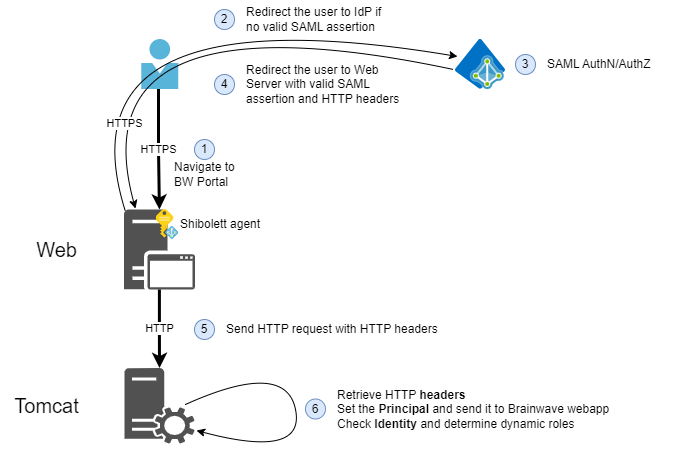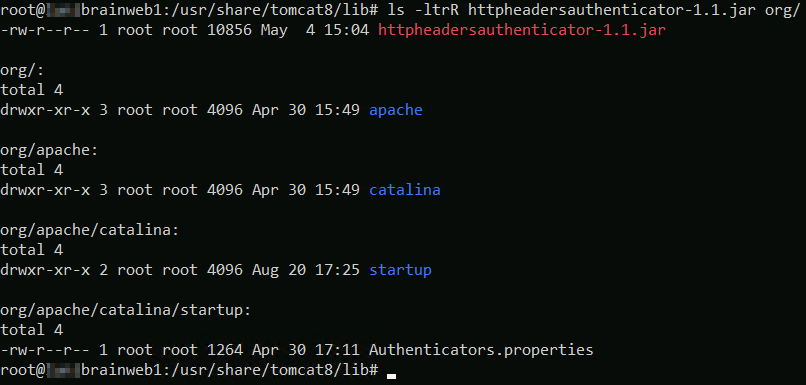HTTP Headers Access
This kind of access mechanism is possible when the AuthN/AuthZ process is delegated to an upstream component (a Shibbolett agent deployed in an Apache Web Server for instance).
It supposes that the AuthN/AuthZ module inserts credentials information in headers of the HTTP request.
The schema below represents the cinematic behind this kind of access:

The following procedure should work:
- With
Tomcat 8andTomcat 9 - Under
WindowsandLinux
Pre-requisites
To ensure this installation procedure, you should first download this archive in the Web Server (i.e. the server that hosts the iGRC webapp).
This archive contains:
- The HTTP Headers Tomcat Valve (
httpheadersauthenticator-1.1.jar) - A configuration
Authenticator.propertiesfile in a dedicated folder (to deploy as-is in the right destination, see later)
It is also admitted that:
- Tomcat instance is installed and available
- The operator has RW privileges in needed files and folders to proceed to the installation
Installation procedure
If you are under Linux, beware of files and folders rights.
The goal of the manipulation is to install an Authenticator and configure the Tomcat to use it in order to manage the HTTP Headers received from the Web Server and, from it, build/set the Principal to send to the iGRC webapp.
In the following procedure, we will use below variables:
Variable | Description | Example value |
|---|---|---|
| Folder that contains Tomcat configuration files | /etc/tomcat8 |
| Folder that contains all libraries used by the Tomcat | /usr/share/tomcat8/lib |
| HTTP Header field name that contain the user login | samAccountName |
| HTTP Header field name that contain all AD groups granted to the user | isMemberOf |
| Separator character used for user groups list in | ; |
| File that contains mapping between AD groups and Portal roles | rolemapping.properties |
| Name of the iGRC Tomcat webapp | sandbox |
| WEB-INF folder of the iGRC Tomcat webapp | /var/lib/tomcat8/webapps/sandbox/WEB-INF |
Here is the steps to follow:
- Unzip the archive in the
<TOMCAT_LIB_FOLDER_HOME>folder

If needed, take care of the files and folders rights.
Under <TOMCAT_CONF_FOLDER> folder
- Create a file
HTTPHeadersAuthenticator.propertieswith the below content - You should set the value according to your context
defaultRoleList=user
loginHttpHeader=<HTTP_HEADER_LOGIN_FIELD>
rolesHttpHeader=<HTTP_HEADER_MEMBERS_FIELD>
rolesSeparator=<HTTP_HEADER_MEMBERS_SEPARATOR_FIELD>
roleMapping=<HTTP_HEADER_ROLE_MAPPING_FILE>
Under <TOMCAT_CONF_FOLDER> folder
- Create a
<HTTP_HEADER_ROLE_MAPPING_FILE>file - Fill it according to your context and following the below format
<SHIBBOLETT_ROLE1>=<PORTAL_ROLE1>
<SHIBBOLETT_ROLE2>=<PORTAL_ROLE2>
...
<SHIBBOLETT_ROLEn>=<PORTAL_ROLEn>
Copy the web.xml file from the <WEB_INF_WEBAPP_FOLDER> folder in the <TOMCAT_CONF_FOLDER> folder
- Rename the copy as
<WEBAPP_NAME>-web.xml - Set the rights accordingly
- At the end of the file, in the
web-appelement, update the Authentication method (see below)
<login-config>
<auth-method>HTTPHEADERS</auth-method>
</login-config>
Note: Take care if you regenerate the WAR file, you should check if the web.xml file has not been modified. If so, you should make again this manipulation.
- Create a file
<WEBAPP_NAME>.xmlunder<TOMCAT_CONF_FOLDER>/Catalina/localhostfolder with the below content- Set the rights accordingly
<?xml version="1.0" encoding="UTF-8"?>
<Context override="true" altDDName="conf/<WEBAPP_NAME>-web.xml">
<Manager pathname="" />
</Context>
Note: Take care of the relative path configured to the deployment descriptor. The base used is the $CATALINA_HOME global variable.
- Open the
server.xmlfile in the<TOMCAT_CONF_FOLDER>folder- If present, remove the org.apache.catalina.realm.UserDatabaseRealm realm
- If, after this removal, the org.apache.catalina.realm.LockOutRealm realm is empty, you can also remove it
<!-- Use the LockOutRealm to prevent attempts to guess user passwords
via a brute-force attack -->
<Realm className="org.apache.catalina.realm.LockOutRealm">
<!-- This Realm uses the UserDatabase configured in the global JNDI
resources under the key "UserDatabase". Any edits
that are performed against this UserDatabase are immediately
available for use by the Realm. -->
<Realm className="org.apache.catalina.realm.UserDatabaseRealm"
resourceName="UserDatabase"/>
<!-- </Realm> -->
Debug
To debug the authentication settings, you can add the following information at the bottom of your <TOMCAT_CONF_FOLDER>/logging.properties:
# To see debug messages for HttpHeader Valve, uncomment the following line
com.brainwave.utils.level = ALL
Where all steps have been performed, you can restart the Tomcat service. Logs should be visible in catalina log files.
Security
Ensure the Tomcat is listening only on localhost and reachable only from Apache for HTTP protocol. You can make this check in the <TOMCAT_CONF_FOLDER>/server.xml.
